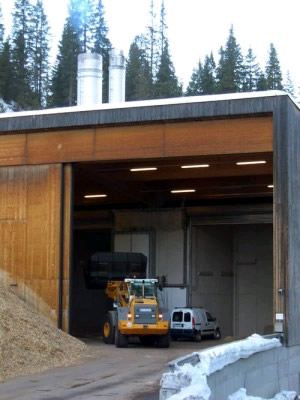
- Recent town of Vail community survey identifies parking as top issue for townies
- Vail Christian High School board buys back bonds, rescues next school year
- Vail Resorts to host Lindsey Vonn celebration in Vail Wednesday, March 31
- Vail Resorts Epic Pass, Summit Pass available through November 30, 2009
- 9 candidates, including 3 incumbents, running for 4 Vail Town Council seats Nov. 3
- Nominating petitions for four open Vail Town Council seats available Sept. 14
- Eagle County commissioners to vote Tuesday on temporary marijuana dispensary regulations
- Vail Town Council rejects ballot question to change council terms
- Polis defends health-care reform at packed town hall in Edwards
- Vail blaze illustrates need for defensible space, roadless rule changes, state says
- All Real News Articles
April 17, 2009 — Funding sources to turn millions of acres of dead and dying lodgepole pines into biomass-generated heat and electricity are seemingly coming out of the woodwork.
With the governor’s Energy Office pushing state grants and aggressive renewable-energy programs — coupled with the potential for millions in federal stimulus dollars — the beetle-kill biomass dreams of ski towns like Vail and Avon no longer look like a kooky environmentalist’s pipe dream.
Vail has considered the possibility of a wood gasification biomass power plant since at least 2005, when town leaders first began expressing wood envy of a sister ski resort in Lech, Austria. That resort heats about 90 percent of its lodges with biomass heat.
Susan Innis, Colorado Carbon Fund program manager for the governor’s Energy Office, said recently that a biomass plant is exactly the type of project participants in the carbon fund could help underwrite by buying tax-deductible energy offsets.
“It would be great to get something like what they have over there in Austria going in one of these mountain communities,” Innis said. “For the Colorado Carbon Fund, biomass projects are a great type of project that we’re looking to buy offsets from. Between all of these various programs and the governor’s Energy Office and some federal grants that are going to be coming down the pike this year, we’re hoping to get more of those projects off the ground.
Wood gasification incinerates chipped wood at extremely high temperatures, heating water that is then circulated throughout a community. The process allows condo complexes, lodges, hotels and even private residences to tap the system’s radiated heat. In Austria and other parts of Europe, such systems are popular because they replace older, inefficient heating-oil boilers and allow mechanical areas to be used as guest rooms, spas or storage.
Vail officials held a public meeting on the topic in March and discussed the potential of using town land for the clean-burning plant, which produces very few emissions. The local electric co-op, Holy Cross Energy, expressed an interest in the plan.
“Actually, yeah, we are fairly involved in looking at beetle-kill biomass and also looking at the possible potential of some bio-fuel, which probably wouldn’t happen up there but would happen someplace in our service territory,” said Holy Cross CEO Del Worley, whose coverage area extends from Vail to Aspen.
“In fact, our internal generation engineer and also our consulting engineer have looked at the technology and we’re satisfied the technology works. It’s just a matter of getting a site, getting the forest contracts.”
Mountain towns in Colorado are typically surrounded by vast swaths of federal land, much of which is now carpeted in rust-red dead pine trees killed by the voracious mountain pine bark beetle, which scientists say have proliferated due to warm temperatures, drought, and fire suppression.
Vail and other mountain towns have spent millions of dollars cutting down dead trees in an effort to create defensible spaces from which to fight inevitable wildfires. Most of those trees have been trucked at great expense to plants that make pellets for wood-burning stoves.
State Rep. Christine Scanlan, a Dillon Democrat, whose district has been one of the hardest hit by the beetle-kill epidemic, has been pushing legislation to mitigate fire danger while doing something productive with all of those dead trees.
One of the goals of Scanlan’s Colorado Healthy Forests and Vibrant Communities Act (HB 1199), which passed out of the House on a 59-1 vote last week, is to create a revolving loan fund for companies to find new ways to use timber removed in the wildfire mitigation process.
But the cost of a biomass gasification plant (Middlebury College in Vermont just installed one for $12 million) dwarfs the funds dedicated to forest fuels reduction by HB 1199 ($3 million in 2009-2010).
“The Colorado Forest Service is charged with setting up the fund and making the rules,” Colorado House Democratic spokeswoman Holly Shrewsbury said. “There is nothing to preclude them from using the funds to pay for biomass plants. However, the fund is small. This means that they will probably look at more targeted investments — like funding people to pull the wood. However, it still needs to go through the rule-making process, so there is a possibility it could happen.”
![]() Comment on "Potential funding sources for Vail Valley beetle-kill biomass plant growing" using the form below
Comment on "Potential funding sources for Vail Valley beetle-kill biomass plant growing" using the form below












